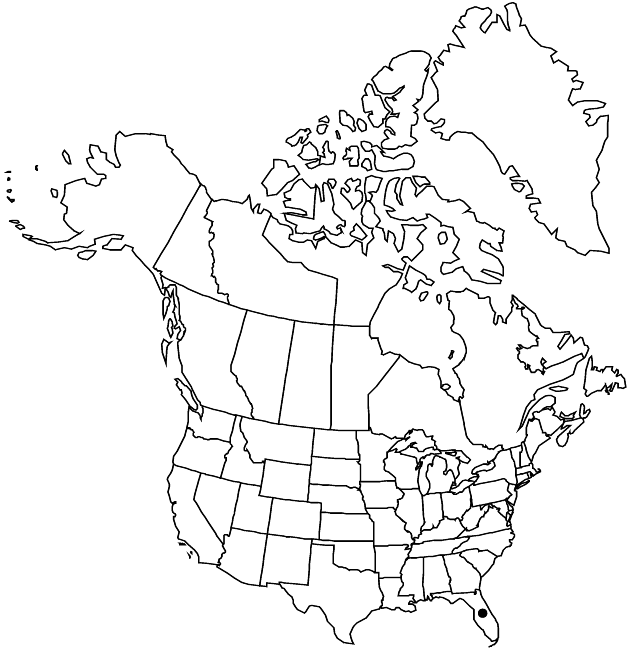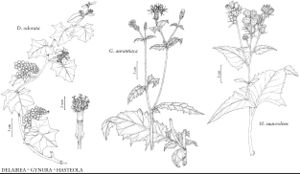Difference between revisions of "Gynura aurantiaca"
in A. P. de Candolle and A. L. P. P. de Candolle, Prodr. 6: 300. 1838.
FNA>Volume Importer |
imported>Volume Importer |
||
| (2 intermediate revisions by 2 users not shown) | |||
| Line 1: | Line 1: | ||
{{Treatment/ID | {{Treatment/ID | ||
|accepted_name=Gynura aurantiaca | |accepted_name=Gynura aurantiaca | ||
| − | |accepted_authority=(Blume) | + | |accepted_authority=(Blume) de Candolle |
|publications={{Treatment/Publication | |publications={{Treatment/Publication | ||
|title=in A. P. de Candolle and A. L. P. P. de Candolle, Prodr. | |title=in A. P. de Candolle and A. L. P. P. de Candolle, Prodr. | ||
| Line 8: | Line 8: | ||
}} | }} | ||
|common_names=Velvet plant | |common_names=Velvet plant | ||
| + | |special_status={{Treatment/ID/Special_status | ||
| + | |code=I | ||
| + | |label=Introduced | ||
| + | }}{{Treatment/ID/Special_status | ||
| + | |code=F | ||
| + | |label=Illustrated | ||
| + | }} | ||
|basionyms={{Treatment/ID/Basionym | |basionyms={{Treatment/ID/Basionym | ||
|name=Cacalia aurantiaca | |name=Cacalia aurantiaca | ||
| Line 30: | Line 37: | ||
|elevation=0–50 m | |elevation=0–50 m | ||
|distribution=Fla.;se Asia;also introduced e Africa (including Madagascar) and Australia. | |distribution=Fla.;se Asia;also introduced e Africa (including Madagascar) and Australia. | ||
| + | |introduced=true | ||
|discussion=<p><i>Gynura aurantiaca</i> is a tender pot-plant that is sometimes grown outdoors. It is marginally established in the flora, persisting as an escape from cultivation in southern Florida. It may be encountered elsewhere along the Gulf Coast. The orange, filiform appendages of the style branches are distinctive; the flowers are reported to be unpleasantly scented.</p> | |discussion=<p><i>Gynura aurantiaca</i> is a tender pot-plant that is sometimes grown outdoors. It is marginally established in the flora, persisting as an escape from cultivation in southern Florida. It may be encountered elsewhere along the Gulf Coast. The orange, filiform appendages of the style branches are distinctive; the flowers are reported to be unpleasantly scented.</p> | ||
|tables= | |tables= | ||
| Line 39: | Line 47: | ||
-->{{#Taxon: | -->{{#Taxon: | ||
name=Gynura aurantiaca | name=Gynura aurantiaca | ||
| − | |authority=(Blume) | + | |authority=(Blume) de Candolle |
|rank=species | |rank=species | ||
|parent rank=genus | |parent rank=genus | ||
| Line 53: | Line 61: | ||
|publication title=in A. P. de Candolle and A. L. P. P. de Candolle, Prodr. | |publication title=in A. P. de Candolle and A. L. P. P. de Candolle, Prodr. | ||
|publication year=1838 | |publication year=1838 | ||
| − | |special status= | + | |special status=Introduced;Illustrated |
| − | |source xml=https:// | + | |source xml=https://bitbucket.org/aafc-mbb/fna-data-curation/src/2e0870ddd59836b60bcf96646a41e87ea5a5943a/coarse_grained_fna_xml/V19-20-21/V20_1368.xml |
|tribe=Asteraceae tribe Senecioneae | |tribe=Asteraceae tribe Senecioneae | ||
|genus=Gynura | |genus=Gynura | ||
Latest revision as of 20:00, 5 November 2020
Stems somewhat lax or clambering, branching, fleshy, conspicuously fuzzy-hairy (± velutinous to villous, crosswalls of hairs purplish). Leaves: petioles 0–3+ cm; blades 4–10(–15) × 2–5(–8) cm, margins raggedly toothed, faces ± velutinous to villous, hairs purplish. Heads 1–5. Calyculi: bractlets 3–6+ mm. Phyllaries 10–12+ mm, tips greenish or minutely darkened. Disc corollas yellow or orange to brick-red (drying purplish), 8–12+ mm; style-branch appendages orange, 1–2 mm. Cypselae glabrous; pappi 10–12 mm. 2n = 20.
Phenology: Flowering spring–winter.
Habitat: Shaded, damp sites
Elevation: 0–50 m
Distribution

Introduced; Fla., se Asia, also introduced e Africa (including Madagascar) and Australia.
Discussion
Gynura aurantiaca is a tender pot-plant that is sometimes grown outdoors. It is marginally established in the flora, persisting as an escape from cultivation in southern Florida. It may be encountered elsewhere along the Gulf Coast. The orange, filiform appendages of the style branches are distinctive; the flowers are reported to be unpleasantly scented.
Selected References
None.
